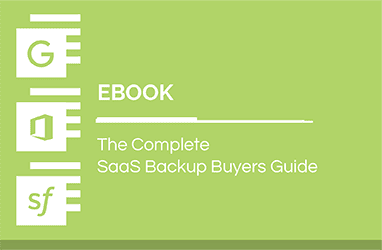5 Key Differences in Email Backup and Retention between Google Workspace and Microsoft Office 365
 Remember when cloud-based services were considered just a passing fad? It’s now clear that the cloud is here to stay, with a projected $106B in revenue for the SaaS software industry in 2016. And two technology giants have been jockeying for the top spot in that industry, hoping their cloud-based business productivity suites will keep momentum for the cloud flowing, along with a sustainable long-term revenue source.
Remember when cloud-based services were considered just a passing fad? It’s now clear that the cloud is here to stay, with a projected $106B in revenue for the SaaS software industry in 2016. And two technology giants have been jockeying for the top spot in that industry, hoping their cloud-based business productivity suites will keep momentum for the cloud flowing, along with a sustainable long-term revenue source.
The battle between Microsoft and Google began in earnest in 2011 when Microsoft introduced Office 365 to the world, a year after Google announced that Google Workspace was no longer in beta. Since then, vast improvements have been made in Google Workspace for Work and Office 365, and adoption rates have continued to climb. Today, more than five million companies have gone Google, and one in four Microsoft enterprise customers uses Office 365, according to Microsoft.
As organizations make the move to the cloud, they inevitably find themselves comparing the two solutions in terms of price, functionality, security, and storage capacity. One important component here – and one that varies quite a bit between the two offerings – is the native backup, retention, and data protection policies included with the SaaS services.
Two Email Applications with Distinct Differences in Backup and Retention Policies
To help you better understand these critical aspects of Google Workspace for Work and Office 365, we’re going to examine the capabilities of the two solutions and give you a better idea of what’s covered by each provider, and, importantly, where there are gaps in data protection. In the table below, we compare the key features and policies offered in the mail applications for Google Workspace for Work and Office 365 as they relate to the following:
- Data retention
- Data purging
- Deleted item storage
- Deleted account data management
- Litigation holds
| Action | Key Difference | Google Workspace for Work Gmail | Office 365 Mail |
|---|---|---|---|
| Data Retention Period | Google will automatically delete email after 30 days. Both will delete email from secondary retention. | Recycle Bin: Data restoration for deleted email is limited to 30 days for end users. Administrative restore: Google Workspace admins can restore emails 25 days after being removed from Recycle Bin. | Deleted items folder: No automated retention policy, but can be configured. Recoverable Items folder: Default retention is 14 days, which can be extended by admin (via powershell) to 30 days. |
| Manual Purging | The services are very similar. Google keeps data for 25 days after trash is emptied, Microsoft defaults to 14 days. | Recycle bin purge: Users and Admins can empty the recycle bin at any time and admins cannot prevent users from doing so. Administrative restore: cannot be purged | Deleted items purge: Users and Admins can empty the Deleted Items folder at any time and admins cannot prevent users doing so. Recoverable Items: Can be emptied by end users at any time, however the data is still available to admins for the defined duration. |
| Recycle Bin/ Deleted Items Storage | Microsoft can be configured to automatically archive or delete data when storage quotas are met. | Storage limit is 30 GB per user (across all Drive, Gmail, and Photos accounts). Google for Work Unlimited users do not have a limit for storage (unless the org has 4 or less users). When limits are hit, users can no longer send or receive any new mail. | Deleted items storage counts towards the mailbox limit. For E1-E4, Education, and all government plans, total size before an account is over capacity is 50GB. Archive and deletion policies can be coded based on quota limits. If the recoverable items folder quota is met, users cannot delete email from their account. |
| User Account Deletion | Microsoft keeps data for deleted accounts much longer than Google: 30 days vs. 5 days. | User data is available for only 5 days after an account is deleted. | User data is available for 30 days after an account is deleted. |
| Recover data from litigation hold (if configured) | In this case, both services are very complex and manual. [Hint: Spanning Backup can help by automating direct, rapid restores for both apps!] | All data must be exported, downloaded and manually imported back into GMail | Data can be restored with a complex, multi-step process that entails exporting, mapping and uploading to Azure storage. |
For a broader look at a comparison between the two solutions, dig into this article by Grasshopper, and a CIO magazine analysis of the suites.
Fill In the Gaps and Protect Your Gmail or Office 365 Email with Spanning Backup
Regardless of which solution you choose for your email needs, a key takeaway here is that neither provides foolproof backup and recovery options to ensure you never suffer data loss due to factors like hacking, human error, sync malfunctions, and malicious insiders.
As you can observe above, there are gaps in the native data protection provided by Google and Microsoft. And frequently, the policies surrounding backup and retention are so complex and nuanced that it’s difficult for admins and users to understand and track them, leaving opportunities for unexpected data loss.
The easiest way to ensure that your SaaS data is always safe, accessible, and able to be recovered quickly and intuitively is to implement a third-party backup and restore solution. With a backup solution like Spanning Backup for Office 365 or Spanning Backup for Google Workspace, data is automatically backed up each day and can be restored from any point in time, even by untrained end users.
For more information on how to fully protect your SaaS data, view our on-demand webinars: 3 Steps to Create A Rock-Solid Protection Plan for Your Google Workspace Data and On-Demand Webinar: Best Practices for Office 365 Data Protection.





